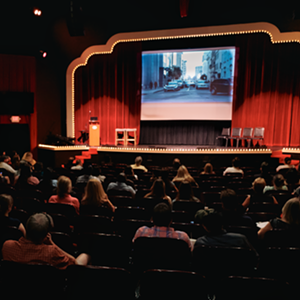FOR AS LONG as anyone can remember, DeRenne Avenue has been the unofficial dividing line between "real" Savannah and its haphazard, generic Southside.
When he published Midnight in the Garden of Good and Evil 20 years ago, John Berendt implied it was mostly oldtimers who thought this way. But these days, even new arrivals to town quickly adopt the local custom of sneering at the Southside — which despite all the snark is still where the vast majority of Savannahians call home.
Not only the ugliest of gateways to an already unattractive part of town, DeRenne itself is one of the most infuriating roadways you'll encounter, both for its aggressive unfriendliness to any mode of transport other than cars as well as the lack of maneuverability once you're stuck in that traffic.
"There's no real reason DeRenne should cut off our community between the Southside and the Northside," says Susan Broker, director of the City's Citizen Office.
"You should be able to cross DeRenne and go to a restaurant. It should be the real mid-city gateway into the community."
You should and it should, but right now you can't and it isn't. About 60,000 cars a day use DeRenne, twice the traffic it was designed to handle. They use it to get to Oglethorpe Mall, to get to Georgetown, to get to I-516, to get on and off post at Hunter.
Bicycles? Pedestrians? Fuggetaboutit.
Why is it that Savannah can address north/south traffic at least somewhat reasonably — Truman Parkway, Veterans Parkway, etc — but can't get east/west right?
The answer's rooted in geography.
About half the people on DeRenne aren't trying to move east/west at all, they're trying to go south. But the vast and impenetrable Hunter Army Airfield is in the way, so they're forced to deal with DeRenne.
"Cars going south don't really want to be on DeRenne. We want to take them off early," says Bret Bell, City of Savannah public information director.
Efforts to alleviate traffic on DeRenne began in the '80s, and included ideas as drastic as making it a double-decker highway (!). But the most current, most comprehensive and by far the most humane effort, Project DeRenne, began in 2008.
Broker describes it as "the most expansive and extensive citizen engagement process the City's ever undertaken."
She's not kidding. Since 2008, citizen meeting after citizen meeting and charrette after charrette have taken place, all with the goal of getting complete buy-in from anyone that might be affected by the project.
Project DeRenne's major components: A flyover onto I-516. A traffic circle to move Hunter-bound-and-exiting cars off the roadway sooner. And a multi-use, boulevard-style makeover of the west end.
"The money is going into the interchange and the bridge at I-516," explains Broker. "The beautification isn't where the real money is, but it makes the project sustainable for the neighborhoods it's adjacent to."
In a constantly shifting world of half-assed, top-down bureaucratic ideas born out of committees, Project DeRenne — virtually unchanged since it was proposed five years ago — is seemingly not of that world.
"The reason efforts to fix DeRenne never worked in the past is there was no citizen involvement," Broker says. "This one's different. We went to the community and said yes there's a traffic problem, but the other part is economic growth and neighborhood sustainability. People support what they help create."
But you wouldn't know it from last week's City Council meeting, where some residents of the Poplar Place neighborhood at Montgomery and I-516 found a forum for objection. They and their elected representatives on Council seemed surprised, even after all the years of preparation and outreach.
Some are angling for a buyout of homes they say was promised by the City. But any such promise, if made, was rendered inoperable by the failure of the TSPLOST referendum in 2012.
Now, instead of local funds, Project DeRenne needs federal matching funds to be finished, to the tune of about $70 million.
The rub is that while Poplar Place doesn't have historic status now, it's eligible, making it against the law to use federal funds to damage its fabric. In other words, if those homes are bought out, the project can't get the federal funds it's dependent on.
It's almost a Catch-22, but there is an out. When Project DeRenne was approved by City Council in 2010 under then-mayor Otis Johnson, it was explicitly contingent on buyouts not impacting the ability to receive adequate funds.
Sadly and perhaps unavoidably, in holding up the project some homeowners are in essence fighting to make their property values even lower than they already are.
"That area's not exactly a country road now as it is," says Bell. "There's no pedestrian or bicycle access. There's lots of traffic from Montgomery to White Bluff. It's a clogged, dangerous road. Project DeRenne would put more cars on that road, yes, but because of the multi-use aspects it would also be a more complete road. Homes on Hampstead Avenue would actually be further away from the road than they are now."
Enter politics. Some City Council members, chief among them Estella Shabazz, who represents the bulk of Poplar Place, seem to be advocating for a more extensive citizen payout than advisable or even permissible. This threatens to put the project back to square one after Council approved it in 2010 and area residents overwhelmingly approved it as recently as April 2013.
"We thought we would've been so far ahead of this project now, but we're still stuck in the same place," a crestfallen Mayor Edna Jackson was quoted last week.
If true, it's not because of any lack of foresight on the part of the people who designed Project DeRenne. As with most things, for better or worse the answer will be a good bit messier, and will have to come from politicians and the people who elect them.




























